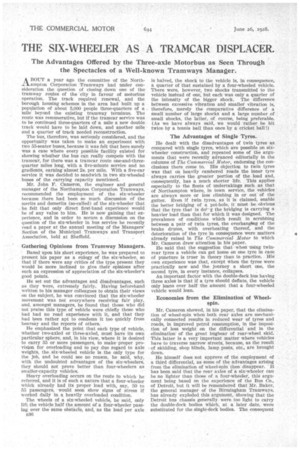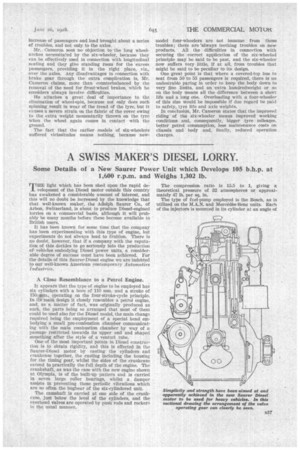THE SIX-WHEELER AS A TRAMCAR DISPLACER.
Page 62

Page 63

If you've noticed an error in this article please click here to report it so we can fix it.
The Advantages Offered by the Three-axle Motorbus as Seen Through the Spectacles of a Well-known Tramways Manager.
A BOUT a year ago the committee of the North_tlampton Corporation Tramways had under consideration the question of closing down one of the tramway routes of the city in favour of motorbus operation. The track required renewal, and the borough housing schemes in the area had built up a population of about 5,000 people three-quarters of a milebeyond the existing tramway terminus. The route was remunerative, but if the tramcar service was to be continued three-quarters of a mile a new double track would have to be laid down, and another mile and a quarter of track needed reconstruction.
The bus, therefore, was seriously considered, and the opportunity was taken to make an experiment with two 35-seater buses, because it was felt that here surely was a case where every possible facility existed for showing whether the bus can really compete with the tramcar, for there was a tramcar route one-and-threequarter miles long, with a five-minute service and no gradients, earning almost 2s. per mile. With a five-car service it was decided to sandwich in two six-wheeled buses of the carrying capacity mentioned.
Mr. John F, Cameron, the engineer and general manager of the Northampton Corporation Tramways, recommended the employment of the six-wheeler because there had been so much discussion of the merits. and demerits (so-called) of the six-wheeler that , he felt that only direct first-hand experience would be of any value to him. He is now gaining that experience, and in order to secure a discussion on the question of the six-wheeler in bus service he recently read a paper at the annual meeting of the Managers' Section of the Municipal Tramways and Transport Association, held at SheMeld.
Gathering Opinions from Tramway Managers.
Based upon his short experience, he was prepared to present his paper as a eulogy of the six-wheeler, so that if there were any critics of the type present they would be more inclined to give their opinions after such an expression of appreciation of the six-wheeler's good points.
He set out the advantages and disadvantages, such as they vere, extremely fairly. Having beforehand written to his manager colleagues to obtain their views on the subject, he was convinced that the six-wheeler movement was not everywhere receiving fair play, and, amongst managers, he found that those who did not praise this type of vehicle were chiefly those who had had no road experience with it, and that they had been rather apt to condemn it too quickly from hearsay and the reports of others.
He emphasized the point that each type of vehicle, Whether two-axIed or three-axled, must have its own particular sphere, and, in his view, where it is desired to carry 55 or more passengers, to make proper provision for overloading and to pay due regard to axle weights, the six-wheeled vehicle is the only type for the job, and he could see no reason, he said, why, with the undoubted advantages of the six-wheelers, they should not prove better than four-wheelers as smaller-capacity vehicles.
Heavy overloading occurs on the route to which he referred, and it is of such a nature that a four-wheeler which already had its proper load with, say, 50 to 55 passengers, would soon show signs of stress if worked daily in a heavily overloaded condition.
The wheels of a six-wheeled vehicle, he said, only lift the vehicle half the amount of a four-Wheeler passing over the same obstacle, and, as the load per axle B36 is halved, the shock to the vehicle is, in consequence, a quarter of that sustained by a four-wheeled vehicle. There were, however, two shocks transmitted to the vehicle instead of one, but each was only a quarter of the intensity of the bigger shock, The difference between excessive vibration and smaller vibration therefore, merely the comparative difference of a small number of large shockS and a large number of small shocks, the latter, of course, being preferable. (As we have always said, we would 'rather be hit twice by a tennis ball than once by a cricket ball!)
The Advantages of SingIe Tyres.
He dealt with the disadvantages of twin tyres as compared with single tyres, which are possible on sixwheeler construction, and repeated some of the arguments that were recently advanced editorially in the columns of The Commercial Motor, endorsing the conclusions there come to. His objection, to twin tyres was that on heavily cambered roads the inner tyre always carries the greater portion of the load and, consequently, has a much shorter life. This applies especially to the fleets of undertakings such as that of Northampton where, in town service, the vehicles are always more or less climbing in or out of the gutter. Even if twin tyres, as it is claimed, enable the better bridging of a pot-hole, it must be obvious that the tyre that is do! --g the bridging is carrying a heavier load than that for which it was designed. The prevalence of conditions which result in scrubbing between a pair of twin tyres, the overhang4ng of the brake drums, with overheating thereof, and the deterioration of the tyre in consequence were matters already raised in The Commercial Motor to which Mr. Cameron drew attention in his paper.
He said that the suggestion that when Using twinrear tyres a vehicle can get home on one tyre in case of puncture is truer in theory than in practice. 1E8 own experience was that, except When the tyres were practically new and the journey a short one, the second tyre, in every instance, collapses.
An important factor with the double-deck bus having three axlea is that if a tyre should deflate, the vehicle only leans over half the amount that a four-wheeled vehicle would lean.
Economies from the Elimination of Wheel spin. •
Mr. Cameron showed, in his paper, that the elimination of wheel-spin when both rear axles are mechanically connected results in reduced wear of tyres arid roads, in improved petrol consumption, in the imposition of less weight on the differential and in the elimination of the great bugbear of rear-wheel skid. This latter is a very important matter where vehicles have to traverse narrow'street, because, as the result of skidding, shop blinds, lamp posts,' etc:, are brought down.
He himself does not approve of the employment of a third differential, as some of the advantages arising from the elimination of wheel-spin then disappear. ' It has been said that the rear axles of a six-wheeler can be no lighter than those of a four-wheeler, this argument being based on the experience of the Bus Co., of Detroit, but it will be remembered that Mr. Baker, the general manager of the Birmingham Tramways, has already exploded this argument, showing that the Detroit bus chassis generally were. too light to carry the double-deck bodies which, at a later date, were substituted for the single-deck bodies. The consequent
increase of passengers and load brought about a series of troubles, and not only to the axles.
Mr. • Cameron sees no objection to the long wheelarches necessitated by the six-wheeler, because they can he effectively used in connection with longitudinal seating and they give standing room for the excess passengers, providing it in the right place, viz., over the axles. Any disadvantages in connection with brake gear through the extra complication is, Mr. Cameron claims, more than counterbalanced by the removal of the need for front-wheel brakes, which he considers always involve difficulties.
He attaches a great deal of importance to the elimination of wheel-spin, because not only does such spinning result in wear of the tread of the tyre, but it causes a severe strain on the fabric of the cover owing to the extra weight momentarily thrown on the tyre when the wheel again comes in contact with the ground.
The fact that the earlier Models of six-wheelers suffered vicissitudes means nothing, because new
model four-wheelers are not immune from these troubles; there are 'always teething troubles on new. products. All the difficulties in connection with securing the correct application of the six-wheeled principle may be said to be past, and the six-wheeler now suffers very little, if at all, from troubles that might be said to be peculiar to its design.
One great point is that where a covered-top bus to seat from 50 to 55 passengers is required, there is no lindesirable paring in order to keep the body down to very Ane limits, and an 'extra hundredweight or so on the body means all the difference between a short life and a long one. Overloading with a four-wheeler of this size would be impossible if due regard he paid to safety, tyre life and -axle weights.
In conclusion, Mr. Cameron states that the improved riding of. the six-wheeler means improved working conditions and, consequently, bigger tyre mileages, better petrol consumption, less maintenance costs on chassis and body and, finally, reduced operation charges.




















































































































